There was a time when Google Ads revolved almost entirely around keywords.
Exact match meant exact. Every search term was visible. Bids lived in spreadsheets, and creative came second to targeting.
We can kick, scream, and reminisce all we like, but that era is over. The rules have changed, and so must our approach.
As Jyll Saskin Gales put it:
“Google Ads has evolved far beyond keywords. Performance Max isn’t even a shiny new toy anymore - it’s three years old.”
(PMax is officially a toddler. Feel old yet?)
Few know audiences better than Jyll - a renowned Google Ads coach, ex-Googler, and the founder of Inside Google Ads.
So, to help marketers move beyond keywords and make the most of the targeting tools and strategies available to them, Jyll joined us for a masterclass on advanced audience targeting strategies in Google Ads.
Watch the full session with Jyll here - or keep reading for the written rundown:
Timestamps:
0:00 - Intro & Jyll’s book on bidding strategies
5:05 - Session agenda
7:06 - Jyll’s session on AI Max
8:24 - What audience targeting means today
11:26 - Google’s pre-defined audience categories
13:51 - Audiences based on your data
18:40 - Audiences you SHOULDN’T target
21:30 - Using custom segments to build audiences
24:30 - Custom vs. combined segments
25:50 - Jyll’s audience targeting cheatsheet
29:40 - Google Ads: Beyond keywords
31:50 - Case study
33:22 - Non-linear targeting
38:40 - Building a strategy beyond keywords
40:47 - TL;DR (session recap)
42:38 - Q&A with Jyll
Evolving beyond keywords
Today, keywords function less like hard rules, and more like suggestions.
They’re signals the algorithm can choose to act on (or ignore).
Broad match keywords can trigger ads on barely related queries, and even carefully built audience signals may be bypassed entirely in campaigns like Performance Max. As Jyll put it:
“You can give a broad match keyword to your search campaign. That doesn’t mean you’re actually going to advertise on anything that has to do with your keyword.”
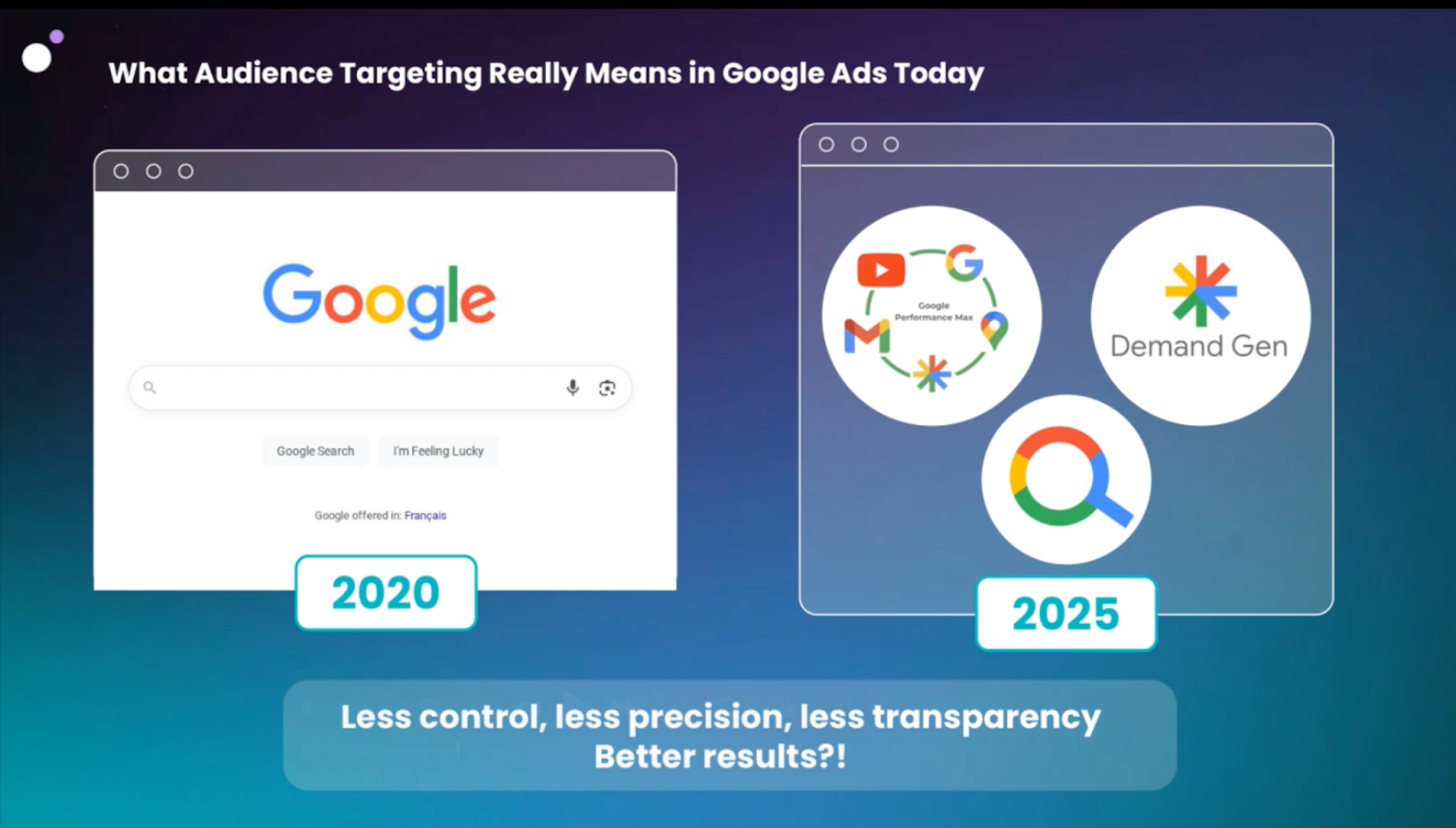
This shift can feel frustrating - marketers have less control, less transparency, and less precision than ever before. But that doesn’t mean the tools are ineffective. In fact, the opposite is true. Those who adapt to the new rules of the game can unlock performance gains their competitors miss.
“We have less control - and yet, there are still so many ways we can drive outstanding results for our own businesses or our clients’ businesses.”
The key is shifting from a keyword-first mindset to one that embraces audience insights, intent signals, and strategic layering. Instead of being your entire targeting, keywords are now just a part of a much broader, more dynamic system.
Use a variety of audience types
Nowadays in Google Ads, audience targeting isn’t optional. It’s essential.
With keyword targeting becoming increasingly abstract, advertisers must lean into the wide range of audience types Google now makes available.
Jyll categorized these into four buckets:
- Google’s built-in data
- Your own data
- Custom segments
- Automation
The first two - Google’s segments and your data segments - are foundational to any well-rounded audience strategy. So let’s take a closer look at each:
1. Google’s built-in audience segments
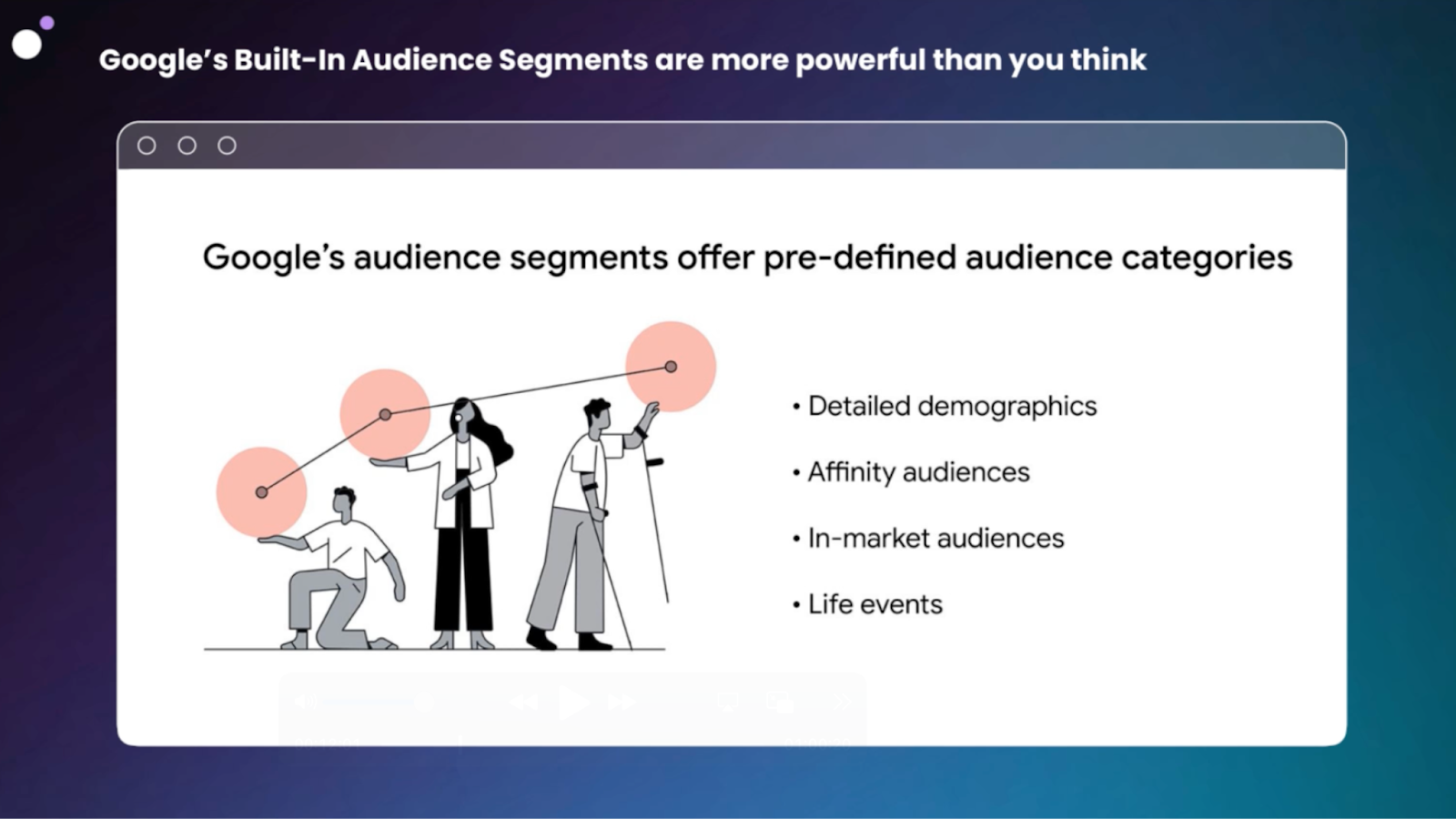
Google’s in-platform audiences are plug-and-play targeting options built from the mountains of behavioral data Google collects across its properties. These are accessible, easy to activate, and highly scalable.
“From Google’s audience segments alone, this is a way that we can take all the data that Google knows about all of us, and just check a box to pick off the people who match exactly what your business is looking for”
Jyll broke them down into four core types:
Detailed demographics
Target based on who someone is - such as parental status, education, employment, or homeownership.
Affinity segments
These segments reflect long-term interests and habits. Whether your audience loves jazz music, luxury shopping, or world travel, there’s likely an affinity segment that fits.
In-market segments
Arguably the most powerful of the bunch, in-market audiences let you target people actively researching specific products or services.
“You can reach people who are in-market for SEO and SEM services, accounting software, or even strollers. There are about a thousand of these to choose from.”
Life events
Target people experiencing major life transitions - like moving, graduating, or getting married. These changes often come with new purchasing behavior, making them high-conversion moments when timed right.
2. Your data segments (first-party audiences)
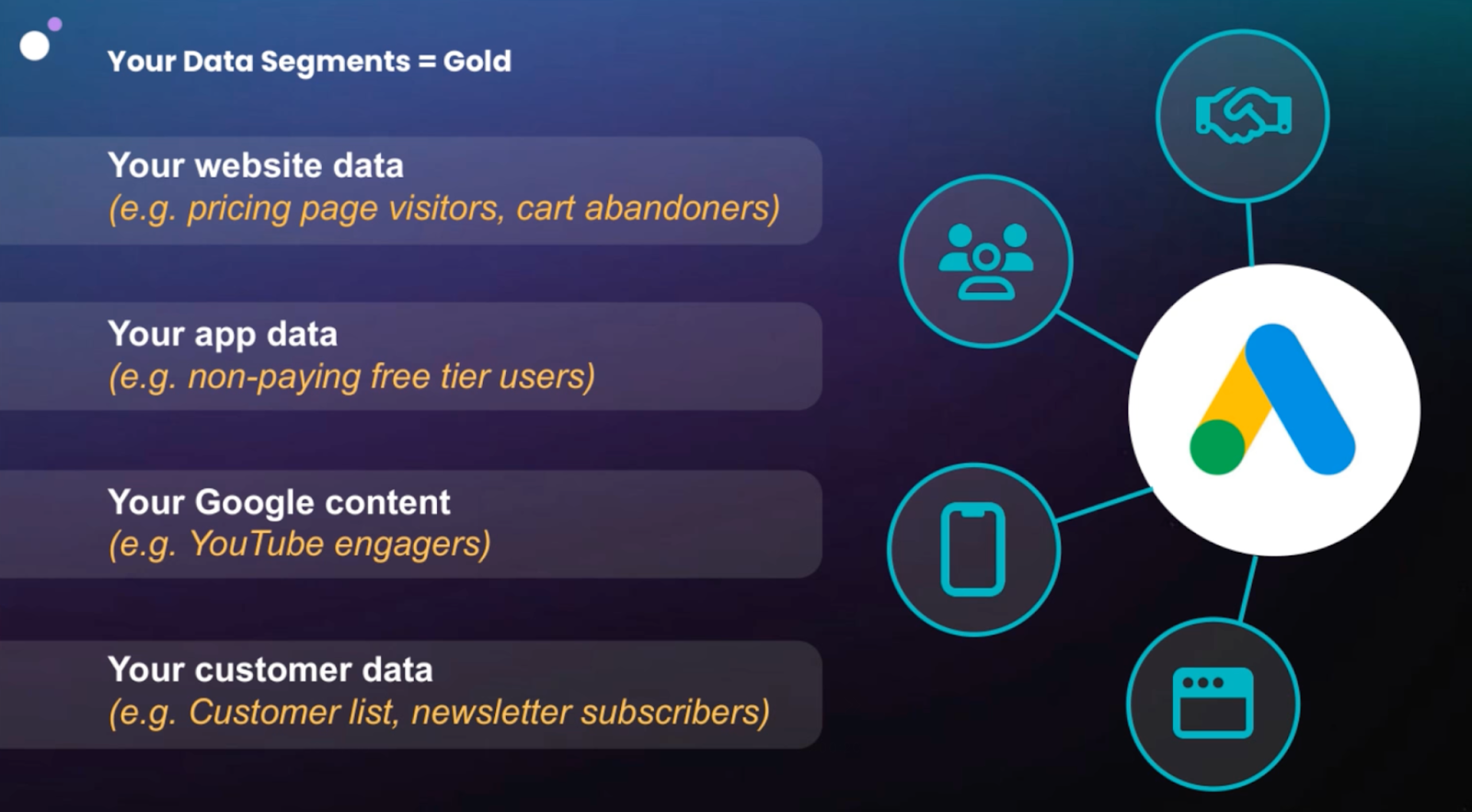
Formerly known as remarketing audiences, these are built using your own data - and they’re only getting more important as third-party cookies start fading away. Jyll called them “super powerful,” and highlighted four types:
Website data
Classic site remarketing - target people who visited your homepage, specific product pages, or those who abandoned their carts. These can be created through Google Tag Manager or GA4.
App data
If you have a mobile app, you can segment based on user behavior - such as free vs. paid users, recent downloads, or high engagement customers.
Customer lists
Upload your CRM data (emails, phone numbers, mailing addresses) to build matched audiences. These are highly effective for both retargeting and exclusion, and they allow you to create lookalike audiences based on your most valuable customers.
Google content engagers
A newer addition - and a standout for small or new advertisers - these audiences are automatically created based on people who’ve interacted with your brand on any Google property (Search, Maps, organic, or paid), which also includes YouTube remarketing segments. Conveniently, this segment doesn’t require tag installation or GA4 setup.
“It is the only kind of remarketing list in Google Ads that you don’t need to set up. You don’t need GA4, you don’t need the Google tag, and you don’t need any technical know-how”
Whether you’re an enterprise brand or a local business just starting out, your data segments are essential for reinforcing relevance and improving performance over time. Used strategically, they can also act as exclusion audiences - helping you avoid wasting spend on job seekers, current customers, or your internal team.
With these audience types at your disposal, you can start replacing the blunt force of keyword-only targeting with smarter, behavior-driven reach.
Custom segments are extremely powerful (and important)
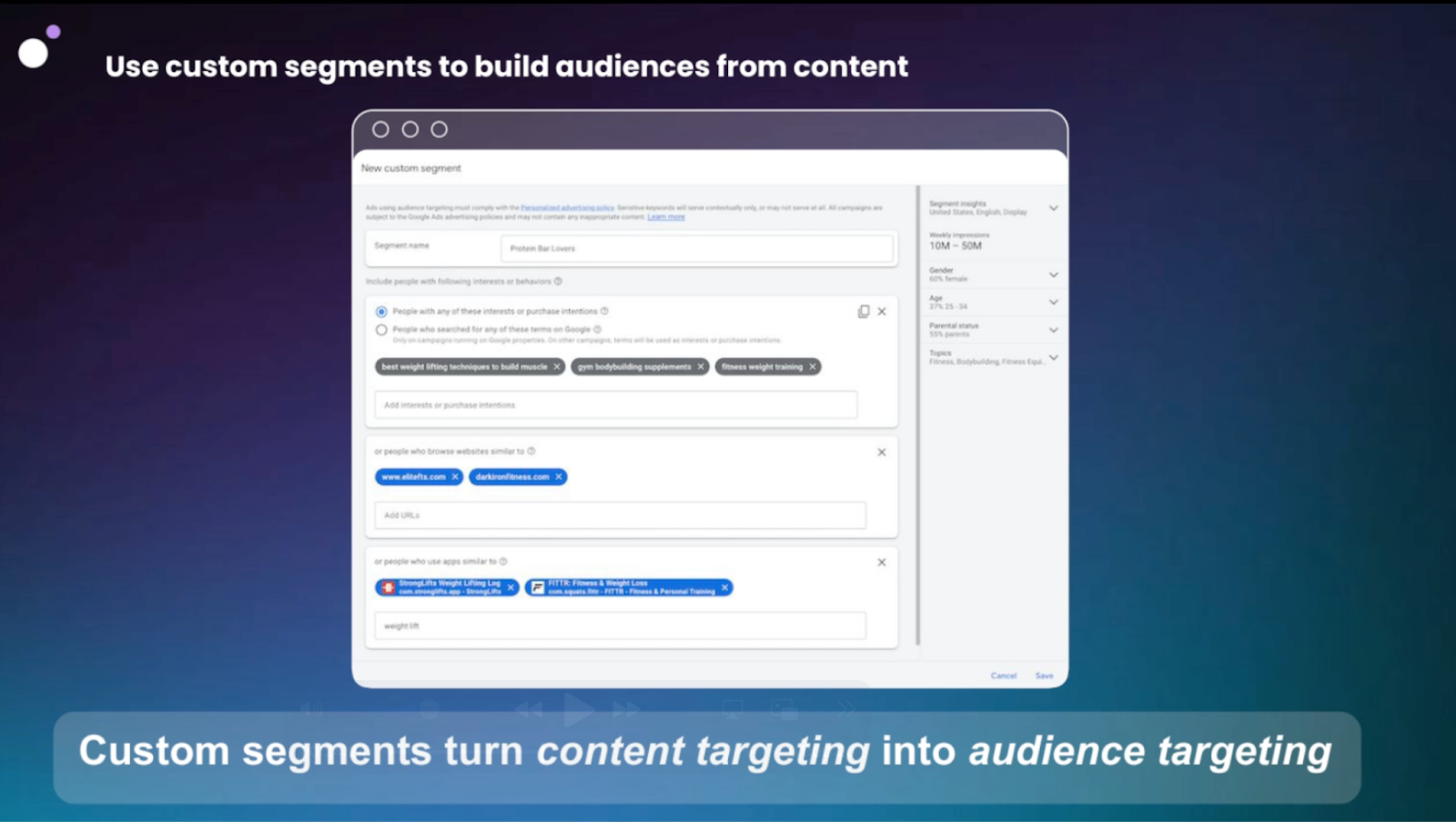
When it comes to advanced audience targeting in Google Ads, few tools offer as much flexibility and control as custom segments.
Unlike pre-defined audience lists, custom segments let you define exactly who you want to reach - based on how they behave online, not just who they are or what they’re searching for in the moment.
“A custom segment is where you can build your own audience based on what Google knows about people. You’re taking Google’s data and slicing it in a way that’s uniquely powerful for your business.”
There are four ways to define a custom segment:
- What people have searched on Google
- Their interests or ongoing browsing behavior
- The types of websites they visit
- The kinds of mobile apps they use
This structure allows you to capture intent that cuts across multiple channels. For example, if you’re targeting B2B software buyers, you can build a segment of users who have searched for high-intent phrases like “best enterprise CRM,” who visit sites like G2 or TechCrunch, or who use business-related apps like Slack or HubSpot.
Jyll framed it simply:
“If you have any kind of content targeting strategy already and haven’t tested custom segments, you’re missing out.”
Importantly, custom segments aren’t constrained to a single campaign type, but they’re especially powerful in Display, video campaigns, and Demand Gen.
In Jyll’s words:
“They’re my favorite kind of audience in Google Ads.”
What about combined segments?
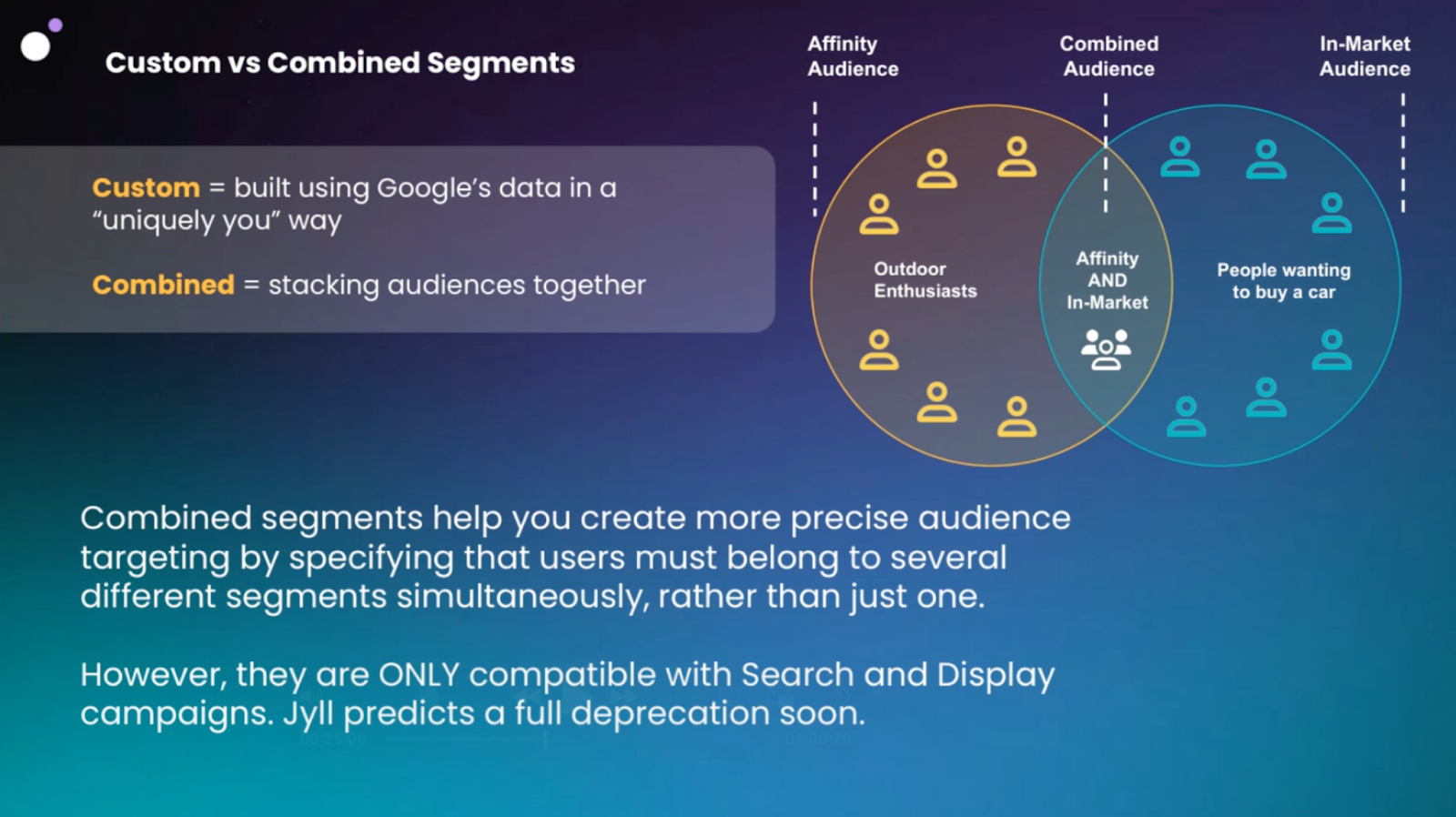
While custom segments let you define who to target based on behaviors, combined segments are about layering multiple audiences together to create more refined intersections.
For example, you might use a combined segment to target users who are both outdoor enthusiasts and in-market for a new car. In theory, this allows for ultra-specific targeting.
But in practice, they offer limited value:
“You used to be able to use combined segments in video and discovery campaigns - now you can’t. They only work in search and display, and honestly, I mostly ignore them now because of that.”
With shrinking support across campaign types and dwindling utility, combined segments are becoming less relevant. Custom segments, on the other hand, remain flexible, widely supported, and deeply effective across channels - making them the better long-term bet for most performance marketers.
Clearly define your offer + audience
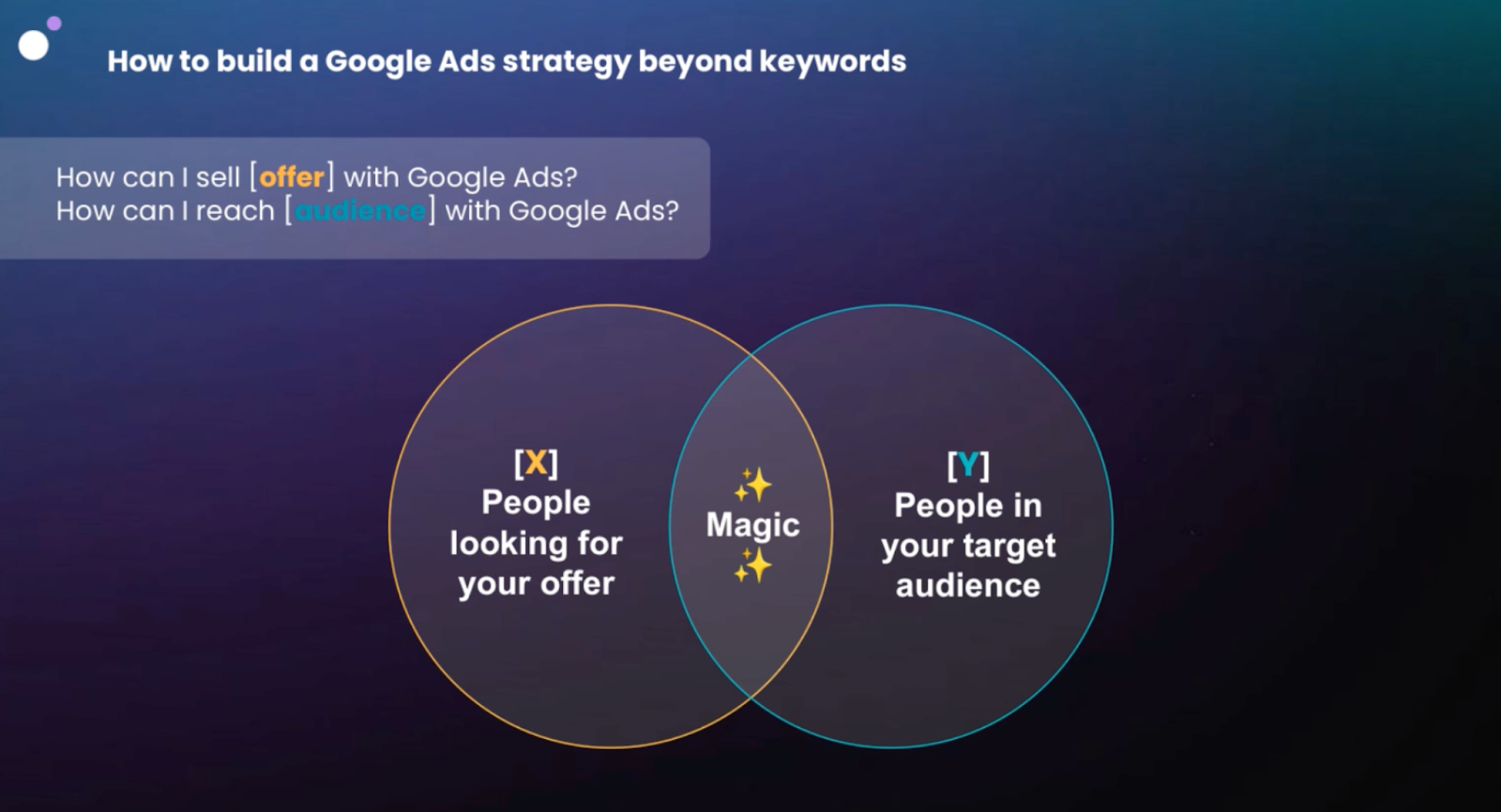
Before diving into campaign setup, audience combinations, or bid strategies, there’s one step that too many advertisers skip - and it’s the reason their Google Ads strategies fall flat:
They haven’t clearly defined what they’re selling and who they’re selling it to.
This sounds basic, but it’s often overlooked. Failing to clarify your offer and your audience is one of the most common mistakes Jyll sees - even among seasoned marketers.
“More than 90% of the Google Ads accounts I see, the business owner or agency doesn’t have a clear answer to these questions - which is why the targeting strategy isn’t working.”
Jyll recommends anchoring your strategy with two key questions:
- What is your offer?
Think beyond categories - get specific. Instead of “software,” is it “mid-market CRM tools for real estate teams”? Instead of “plumbing services,” is it “24/7 emergency pipe repair in suburban Houston”? - Who is your audience?
Be clear on their role, context, and intent. A head of paid media at a B2B SaaS firm has vastly different motivations than a solopreneur or a homeowner - even if they all convert on similar keywords.
Once you have distinct audience segments defined, each one deserves its own tailored strategy - unique targeting, creative, and messaging. Too often, marketers attempt to address multiple personas with a single ad or campaign, diluting relevance and performance.
If you want to use the full power of Google’s audience targeting tools, the first step isn’t technical - it’s strategic clarity. When your offer and audience are precisely defined, everything else - from keyword signals to custom segments - starts to align more naturally.
Lean into non-linear targeting + powerful creative
When direct targeting isn’t possible - due to platform restrictions, sensitive categories, or niche audience definitions - great marketers don’t give up. They get creative.
And that’s where non-linear targeting comes in.
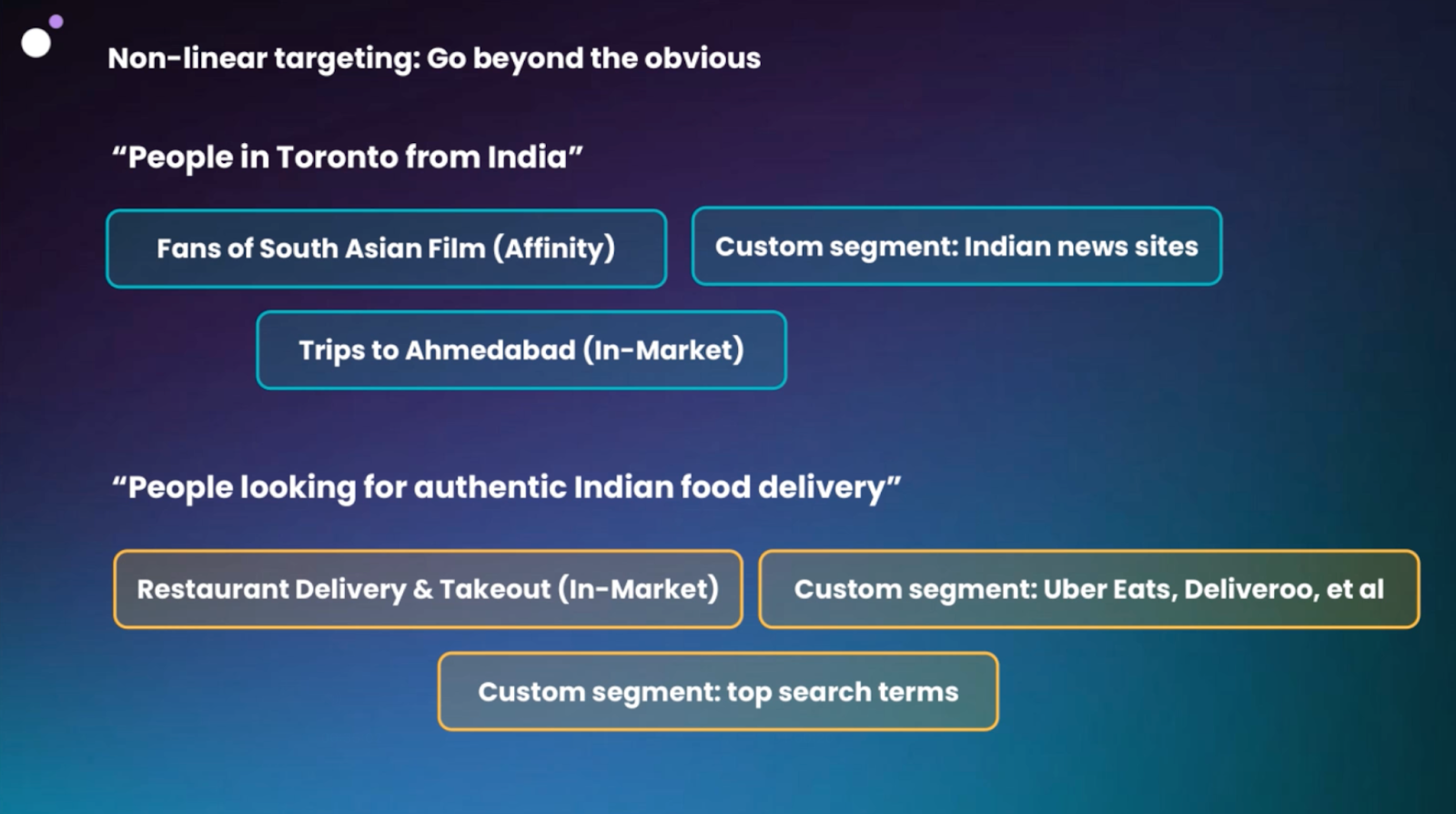
Instead of trying to reach your audience with a direct match (“people from India living in Toronto” or “enterprise decision-makers at B2B tech firms”), non-linear targeting encourages you to think laterally. What else does your audience do? What do they read? What do they buy? What interests, behaviors, or locations overlap with your ideal customer?
Jyll broke it down using a powerful real-world example: helping an Indian food delivery service in Toronto reach members of the Indian diaspora - without ever targeting race, nationality, or ethnicity (which Google rightly prohibits).
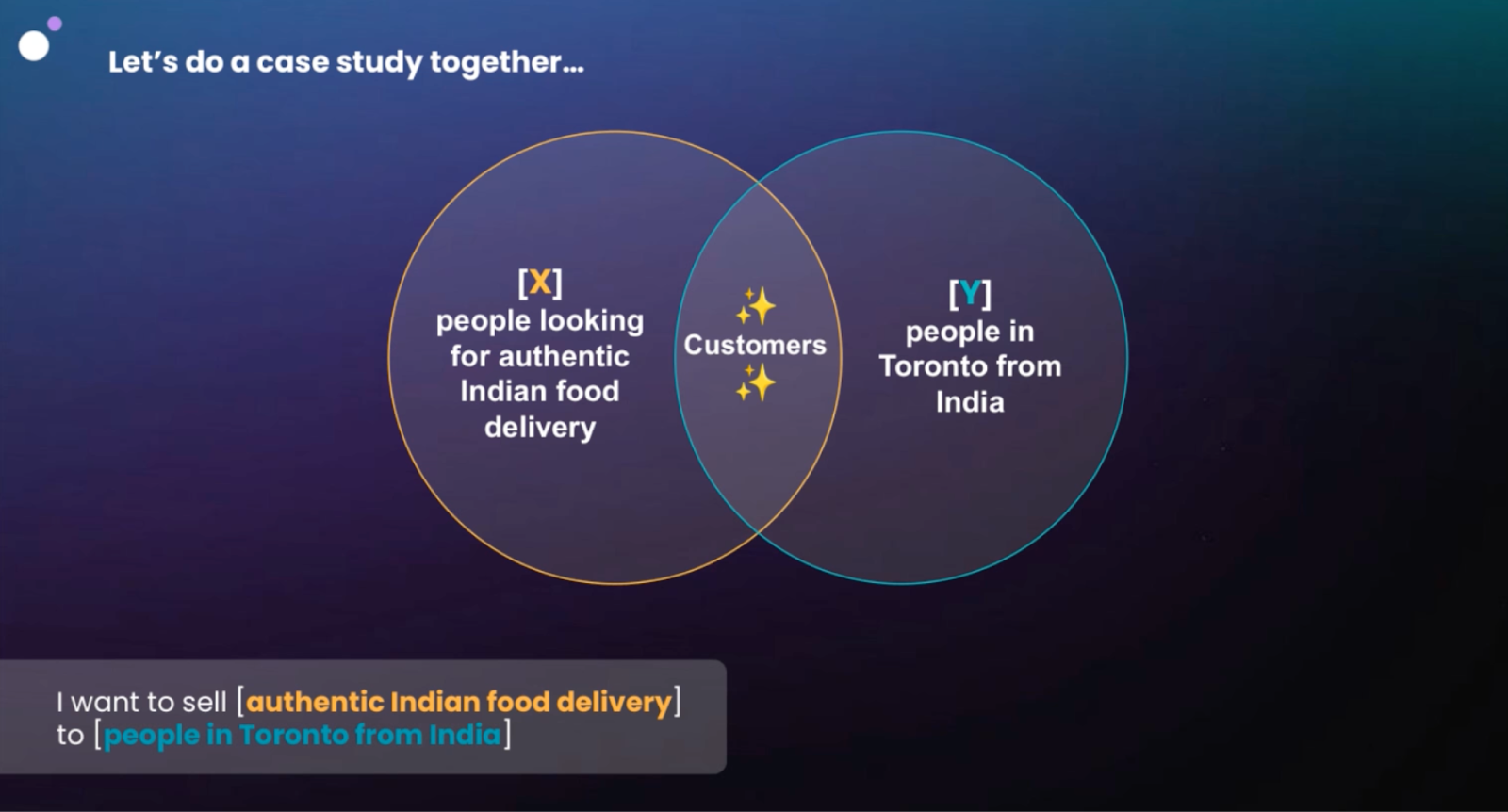
She layered creative alternatives:
- Affinity for South Asian film
- In-market for travel to specific Indian cities
- Visitors to Indian news sites via custom segments
- Use of food delivery apps (like Uber Eats or DoorDash)
“You can’t target people based on race or nationality. But that doesn’t mean you can’t reach them. You just need to think 360 degrees around your audience.”
This approach isn’t just clever - it’s effective. And when paired with creative that acts as a filter, it becomes even more powerful. Your ad copy, imagery, or video isn’t just there to attract - it should also disqualify irrelevant users. For instance, an ad in Hindi will naturally appeal to native speakers while being ignored by others, refining your targeting without needing any additional inputs.
“Whether it’s your text, image, or video ads - it should appeal to your target audience, but just as importantly, it should not appeal to your non-target audience.”
Non-linear targeting paired with deliberate creative helps you reach the right users even when exact targeting isn’t available. It’s a strategic workaround that, in competitive or restricted spaces, can become your biggest edge.
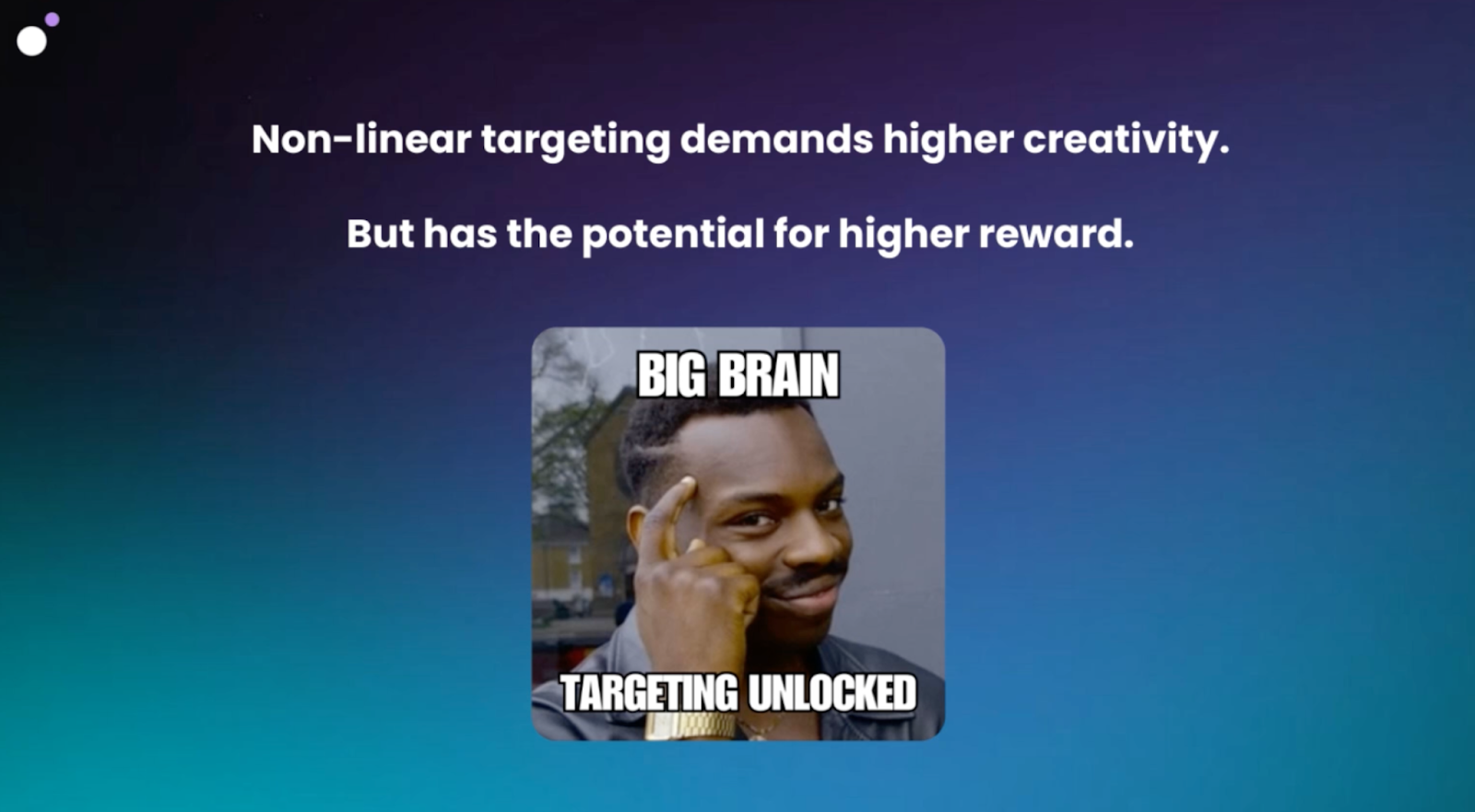
Final thoughts & additional resources
As keyword precision continues to erode and automation expands, audience targeting has become the most powerful lever left in a performance marketer’s toolkit.
By moving beyond default settings and embracing everything from Google’s built-in segments to your own first-party data, custom segments, and non-linear strategies, you gain back control.
It's a common sentiment, but worth reiterating: Success in Google Ads isn’t about fighting against the automation (many have tried, and failed) - it’s about working with it, feeding it smarter inputs, and learning how to use it to your advantage.
“There are still so many ways we can drive outstanding results… but you have to think differently.”
So define your offer. Understand your audience. Build your campaigns with intent. And above all, remember: in a signal-based world, the more clearly you define who you want to reach, the better Google Ads can help you get there.
After the session, Jyll answered numerous questions from the live audience. Watch the full session (Q&A starts at 42:38) to get her insights and breakdowns on highly-requested audience targeting questions.
We wanted to extend a huge thank you to Jyll Saskin Gales for joining us, and for providing such a detailed rundown of the advanced audience targeting strategies marketers should be aware of.
Make sure to follow Jyll on LinkedIn if you’re not already - and check out Inside Google Ads for Jyll’s expert courses, book, and the Inside Google Ads podcast.
Additional resources from the session:
- Follow Jyll on LinkedIn
- Get a 14 day Lunio traffic audit
- Get Jyll’s book on Audience Targeting
- Amazon pulling out of Google Ads auctions - Mike Ryan
- Jyll’s podcast episode about AI Max
- Jyll’s advice on Detailed Demographics
- Jyll’s advice on Affinity Audiences
- Jyll’s advice on In-Market Segments
- Jyll’s advice on Life Events Audience Targeting
- Jyll’s advice on Google-Engaged Audiences
- Jyll’s advice on Re-Targeting Strategies
- Q&A summary w/ Jyll on Retargeting
- Audience exclusions: 11 targeting tips - Lunio
- 5 Ways to Exclude Irrelevant Users - Paid Media Pros
- AbuseIPDB - Known spam / malicious IP addresses
- What is non-linear targeting in Google Ads?
- Lunio case study - Graff Jewlerey
- Lunio case study - Culligan Harvey



